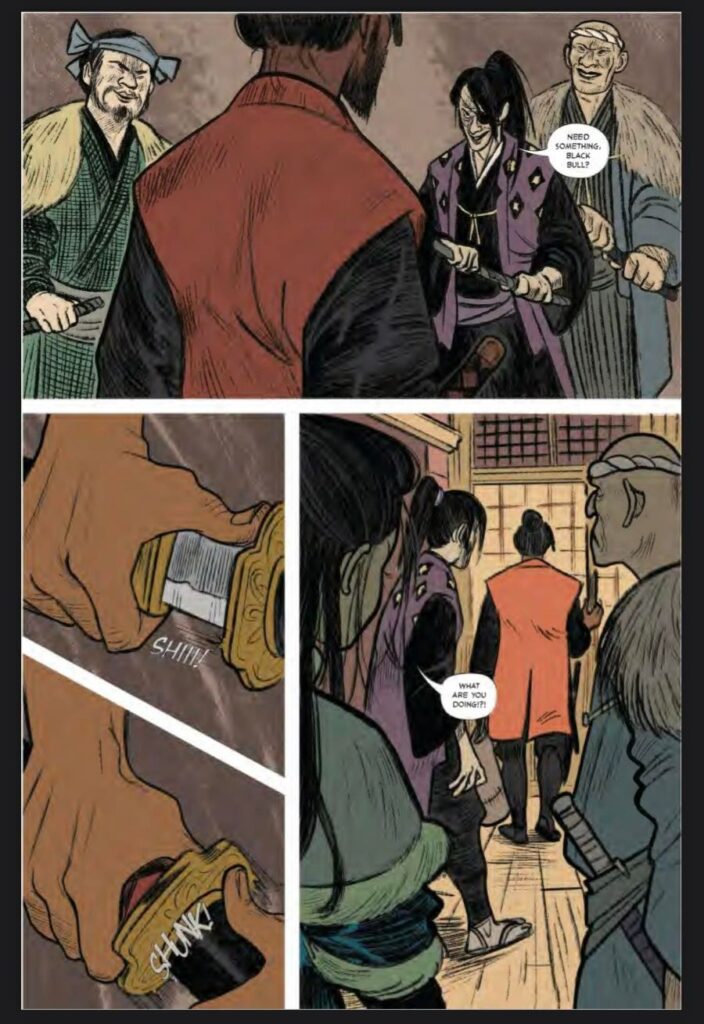Interviewee: H.S. Tak
Interviewer: Anthony Andujar Jr
Q1. What started you on the path of writing in the field of comics? What is it about comic books as a medium that makes it unique compared to other mediums?
Tak: My background was in film and screenwriting but nobody would read my work. It’s tough as an unknown writer to get people’s attention. I had to try and figure out another way to get my stories out. I remembered being deep into the world of comics when I was 12, 13, 14, and reached back there. I started reading comics again and fell back in love with them and just wondered if it could be an alternative way to get my stories out. I got lucky Chris Ryall saw something in one of my pitches early on and gave me my first book at IDW. After that, I just never looked back. You need to find a guy like Chris- someone who believes in you and is willing to open the door.

You want to go to Saturn? Go the fuck to Saturn, bro. You want to go back in time to when primates worshiped stone pillars. Just go. You want to explore a new planet where floating eyeballs shoot laser beams – you can do anything in comics. There’s no budget, no limits, nobody to stop you from telling the story. In comics, there’s no barriers. That’s intriguing to me. It’s challenging and freeing as a writer to have to develop and construct with no boundaries.
Q2. What were some of your influences or inspirations that informed your creative output as a comics writer?
Tak: I’m biting Scorsese here because he said it best. I get inspired by other artists and creators. Their work. They inspire and drive me. They keep me humble and hungry because they’re just so damn good. They are the muse. You can see it in all the great work that’s out right now. We are in a golden age of storytelling I think.
Q3. How did the creative mosaic of inspirations lead to the creation of your book, Hitomi?
Tak: Hitomi was a godsend, man. It was both the easiest and the best thing I’ve ever written at the same time. Normally I struggle with the story and the characters. Slogging through draft after draft. Hitomi came out like a song and I’m not sure I can pinpoint why. Sometimes you get lucky. Muse hits at the right time and you’re ready for it. You put the practice in and when it comes you’re just ready.
Q4. What was the development process like in terms of drafting all the way to finalizing Hitomi?
Tak: Again normally I go through draft after draft. It’s painful. It can get up to 20, 30 drafts depending on the project. I know it’s inefficient as hell. Hitomi was just easy though. It was all one draft and off to Isa. Isa’s process was different though. She was so busy. I had to beg her to do this. She’s done work all over Europe and for the biggest publishers on the globe. Finally, she said yes but her time was so limited. She convinced one of her talented friends Nicoletta Bea to do the layouts and then she would refine and ink them. It was cool to see them collaborate on this world and breathe life into the characters. They found a rhythm and created a masterpiece of an art.

Q5. When writing Hitomi, and the legendary samurai, Yasuke, what led to choosing Hitomi as the central character?
Tak: Yasuke is a known historical figure. Not well known but still his story has been floating around. I had to find another way to get into it rather than the braveheart version. In Lord Nobunaga’s last days, he was encircled by his enemy, and Yasuke was right there with him, one of his closest advisors. But interestingly, in the course of History, Nobunaga and all his closest allies’ deaths were recorded. But Yasuke disappeared. No records, no historical account about what happened to this man. Realistically the Japanese at the time, especially his enemies, probably didn’t consider him a samurai and an equal and felt no need to record his death. But what if that wasn’t the case? What if he somehow escaped and was living out the rest of his days in Japan? That’s where I got interested and that’s where I jumped in. How do you tell this man’s story? Well, I told it through one of his enemy’s eyes.
Q6. In the case of Yasuke as a real-life historical figure, what stuck out to you about the figure that shined through in this version of the character for this series? What were some of the challenges that came with writing this depiction of Yasuke as a mentor figure to Hitomi?
Tak: Who is Yasuke? He lived so long ago we have limited historical accounts. We don’t know where he was born, or what his Mother and Father named him. All we know is when he stepped onto the shores of Kyoto and history begins to speak of him. My feeling is Yasuke in all honesty wasn’t a great warrior, capable of killing Samurai. That’s creative liberty. What he was – was a brilliant individual. Look- a kid who is taken in as a slave is normally dead by age 15 in that time. He somehow survived, crossed the oceans to many different lands, and learned many languages. This gift of learning languages is what kept him alive at first. Rather than working him to death, the Jesuit Priest who owned him understood the kid’s brilliance and brought him along and educated him.
Yasuke survived the Portuguese because he learned to speak Portuguese. Yasuke survived in Japan because he learned to speak Japanese. Nobonaga brought him as a sideshow attraction, like the bearded woman, or the wolfman. A black man in Japan when nobody ever saw that before. But what happened was Nobunaga was in constant warfare, vying to become the Shogun. And Yasuke, having traveled the majority of his youth with the Jesuits (wherever Jesuits went there was bloodshed, crusading, Christianity by the sword) had seen so much war. He was able to advise Nobunaga on strategy and warfare, and this is where Nobunaga was stricken. This black dude from a faraway land is no sideshow. He’s a brilliant thinker and strategist. That’s I think when Nobunaga anointed him into his inner circle and made him an honorary Samurai. So the challenge really is how do you tell this guy’s tale? It felt like trying to draw a panorama on a grain of sand.

Q7. Were there any plans for Hitomi to be a five-issue limited series? How do you determine when a story is a stand-alone limited series or ongoing? And what do you prefer when it comes to writing?
Tak: It’s all instinct for me. You feel the characters and their emotions, you understand when they are done. Hitomi is a standalone but we’re not done. She’s still there and hungry. Look how passionate she was for a dream. Now she has a family, how badly will she protect that? Hitomi and Yasuke have just begun.
Q8. Looking back on the creative process with the rest of the creative team, what is something that you learned while working on Hitomi? Were there any changes in your writing process having worked on this title?
Tak: Every book I do I try to learn and get better. If you track my books you can see it, each one so far has been better than the last thankfully. It’s difficult to pinpoint exactly why but I think it’s just the process of learning what works and what doesn’t, and then trusting yourself to execute on experience.
Q9. Looking back, from the beginning stages of this series to its conclusion, what was your favorite moment of the book that made you proud of the work that you crafted within this series?
Tak: Hitomi was incensed. I mean ready to walk out on Yasuke. He just slaughtered some wood witches who she connected with, empathized with. It was their job but she would’ve rather recanted. But he committed and followed through. Hitomi asks him angrily “This is honor?” He let her have her own sword then. “This is work. Work is honor. But you have a katana. You can decide honor now by the edge of your blade.” He gives her the reins at that moment. He tells her she’s free.
Q10. What projects do you have in the pipeline that readers should check out, and where can they follow your work?
Tak: I have a bunch of stuff in the works I’m excited and nervous about. A book coming through Image with master artist Uko Smith and another with Scout comics. The Scout one is called Crashland and its Indiana Jones in Arabian Nights. It’s about a little girl and an RAF Pilot trekking the ancient Silk Road in dangerous times. Crashland is with DC Comics phenom Amancay Nahuelpan. I am also starting a book with Hitomi’s colorist and a brilliant artist in her own right, Valentina Napolitano. I can’t wait for readers to get to see her in her own book. And yes Hitomi round 2 is coming. Please contact Isa and hound her to return to the stage ;). She is someone who I learned from through her work, her passion, her heart, and is the reason for Hitomi’s success. If you want to reach me hmu up on IG: @hstronic

